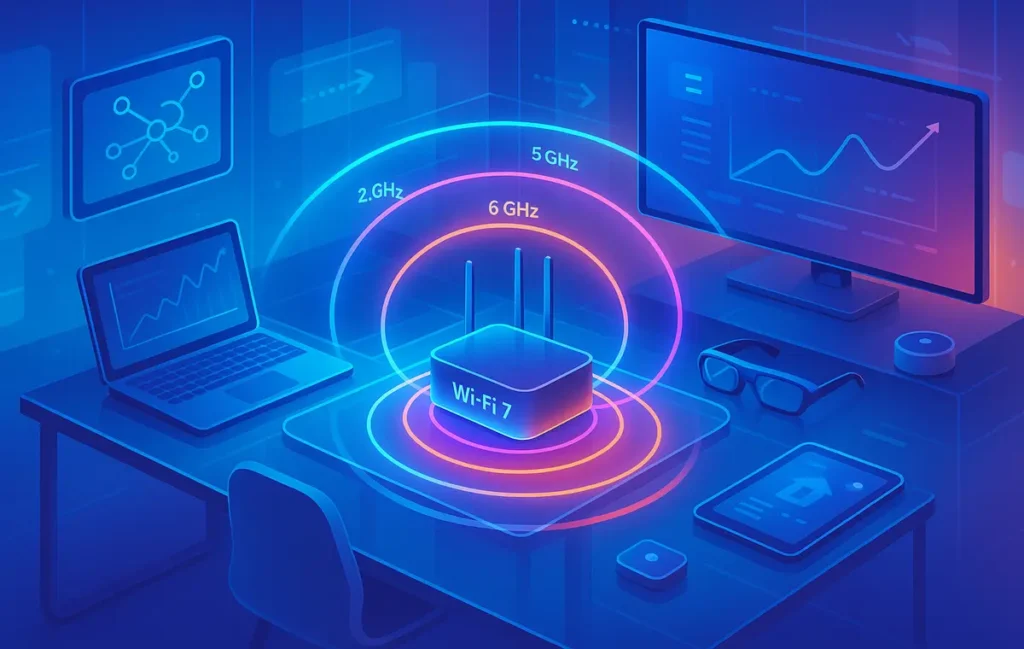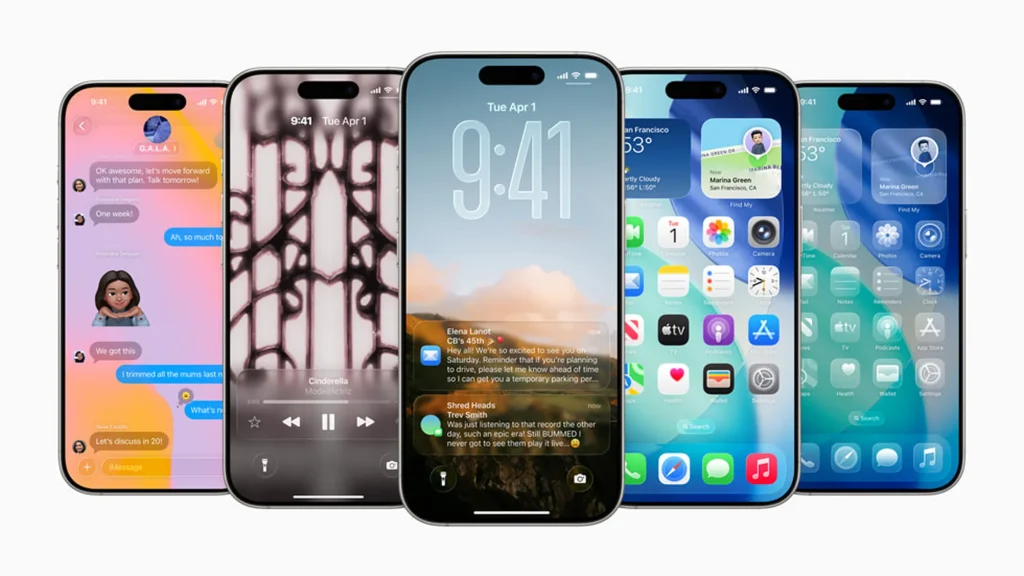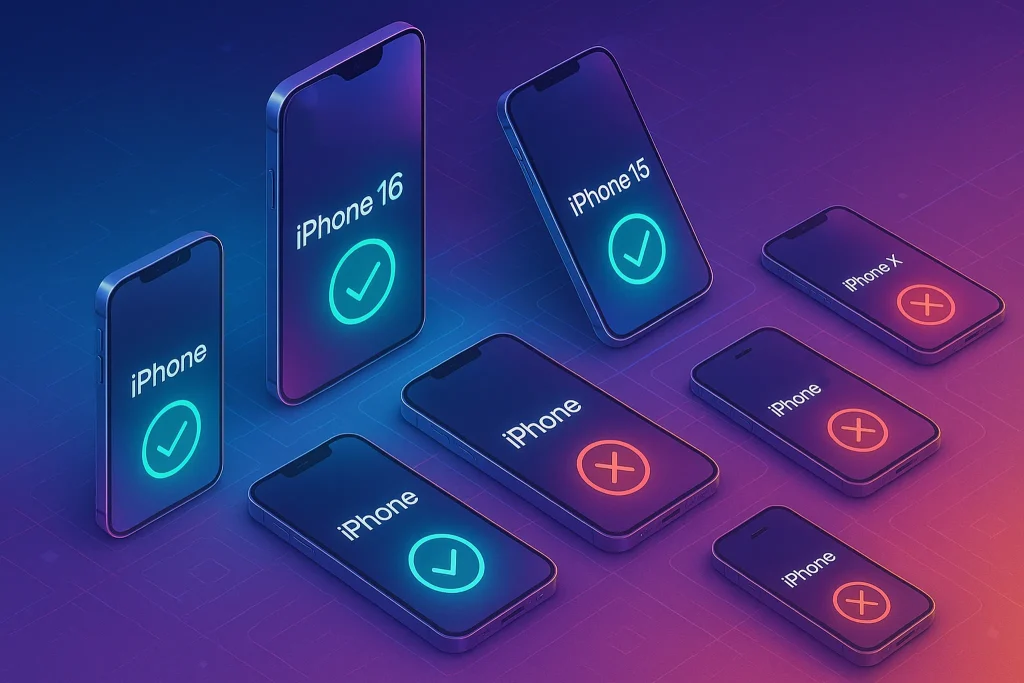🎯 Intro
You know the feeling: you’re on a video call, your laptop is two rooms away from the router, and suddenly the connection stutters. Or you’re streaming a 4K movie with your family while someone else in the house is gaming online—and the network starts to choke. These daily frustrations are why new Wi-Fi standards keep emerging.
Enter Wi-Fi 7 (IEEE 802.11be). It’s not just another bump in numbers—it promises speeds up to 46 Gbps, double-wide channels, smarter modulation, and multi-link magic. But does this translate to real-world gains, or is it another case of theoretical hype?
At NerdChips, we dug into benchmarks, compared it with Wi-Fi 6E, and looked at scenarios that matter to everyday users. The goal: to answer one question—is Wi-Fi 7 worth it right now, or should you wait?
🔍 What’s New in Wi-Fi 7?
Wi-Fi 7 is the next evolution of wireless, designed under the IEEE 802.11be standard. While Wi-Fi 6E opened the 6 GHz band and extended the spectrum, Wi-Fi 7 amplifies efficiency, capacity, and peak performance.
Four innovations stand out:
320 MHz Channels. Wi-Fi 6E maxed out at 160 MHz, but Wi-Fi 7 doubles the lane width. Wider channels mean more data at once—like upgrading from a two-lane road to a four-lane highway.
4096 QAM (Quadrature Amplitude Modulation). While 6E topped out at 1024 QAM, Wi-Fi 7 pushes to 4096 QAM, cramming more bits into each transmission. In theory, this means ~20% higher throughput at the same signal strength.
Multi-Link Operation (MLO). Perhaps the biggest upgrade. Devices can use multiple bands simultaneously (2.4 GHz, 5 GHz, and 6 GHz). Instead of switching between them, Wi-Fi 7 combines them—like driving on multiple highways at once.
Preamble Puncturing & MRU. These spectrum efficiency tricks allow routers to use partially free channels instead of wasting them due to interference. Translation: more reliable connections in crowded environments.
💡 Nerd Tip: Don’t get lost in acronyms. The essence of Wi-Fi 7 is wider, denser, and smarter connections—built for multi-device, high-bandwidth homes.
If you’ve already invested in a high-speed internet plan but still face dead zones or weak connections in your living room or upstairs office, it’s time to rethink your setup. From repositioning your router to upgrading to mesh Wi-Fi systems, there are practical ways to boost your Wi-Fi speed and coverage at home. This guide breaks down simple tweaks and smart upgrades that ensure every corner of your house gets a strong, reliable signal.
📊 Theory vs Real-World Performance
On paper, Wi-Fi 7 looks unstoppable. Peak theoretical speeds approach 46 Gbps, compared to Wi-Fi 6E’s ~9.6 Gbps. But as with every wireless leap, theory rarely matches practice.
In real-world tests, early Wi-Fi 7 routers delivered 4–5 Gbps at close range with compatible devices—faster than 6E, but nowhere near 46 Gbps. Why? Signal loss, interference, and device limitations. As Linus Tech Tips and Tom’s Hardware noted, range plays a huge role: once you move two walls away, Wi-Fi 7 can degrade quickly, sometimes performing only marginally better than 6E.
Still, those raw speeds matter for specific use cases. Multi-gigabit internet plans, 8K streaming, and high-end VR setups finally have room to breathe. But for average households, the bottleneck is often the ISP, not the Wi-Fi. If your internet tops out at 1 Gbps, you won’t “feel” 46.
💡 Nerd Tip: Wi-Fi 7 isn’t just about raw speed. The real gain is stability across many devices at once.
Until recently, satellite internet meant bulky dishes and home installations. But with Starlink’s new mobile plan expansion, SpaceX is bringing satellite internet directly to phones. This move could change the game for travelers, remote workers, and anyone living outside traditional broadband zones. Our coverage of the Starlink mobile rollout shows how close we are to a future where your phone stays connected anywhere on Earth.
⚖️ Wi-Fi 7 vs Wi-Fi 6E (At a Glance)
| Factor | Wi-Fi 6E | Wi-Fi 7 |
|---|---|---|
| Max Channel Width | 160 MHz | 320 MHz |
| Modulation | 1024 QAM | 4096 QAM |
| Multi-Link Operation | ❌ Not supported | ✅ Supported |
| Long-Range Stability | Better (5/2.4 GHz) | Can drop on 6 GHz |
| Peak Theoretical Speed | ~9.6 Gbps | ~46 Gbps |
Wi-Fi 6E was a leap because it opened the 6 GHz band. Wi-Fi 7 builds on that foundation, doubling efficiency and enabling simultaneous multi-band links. But stability at range remains a challenge.
🛠️ Real-World Use Cases
So what does Wi-Fi 7 change for actual users? Let’s look at scenarios:
Fiber-Powered Homes. If you’ve invested in a 2–5 Gbps fiber plan, Wi-Fi 6E often throttles your speed because of channel and modulation limits. Wi-Fi 7 unleashes your connection across compatible devices—finally justifying those high ISP bills.
Gamers & VR/AR Users. Latency is as important as speed. Wi-Fi 7’s MLO reduces packet drops and stabilizes connections, especially when multiple family members are streaming or downloading at once. For VR, where frame drops equal motion sickness, stability is gold.
4K/8K Streaming. Households where multiple TVs stream simultaneously will see smoother playback. No more buffering when one person streams Netflix while another joins a Zoom call.
Crowded Networks. Smart homes with 20+ devices—cameras, thermostats, lights, and laptops—often choke Wi-Fi 6E routers. Wi-Fi 7’s spectrum efficiency ensures fewer conflicts.
💡 Nerd Tip: If your home has fewer than 10 devices and sub-1 Gbps internet, you won’t feel Wi-Fi 7’s benefits just yet.
While Wi-Fi 7 is reshaping home connectivity, the mobile world is racing ahead too. 5G has already transformed how we experience mobile data, but 6G promises even faster speeds, ultra-low latency, and futuristic applications like holographic calls and tactile internet. Our breakdown of 5G vs. 6G explores what’s real today, what’s still research, and how the jump to the next generation of wireless tech will affect everyday life.
⚠️ Limitations & Challenges
Despite the hype, Wi-Fi 7 has limitations. First, signal penetration. The higher the frequency, the weaker it is at traveling through walls. While 6E already faced this, Wi-Fi 7 pushes even further into fragility at distance. Expect to need mesh setups in large homes.
Second, device support. Only the latest flagship smartphones, laptops, and motherboards support Wi-Fi 7. Most of your existing gear won’t benefit yet.
Third, router design and pricing. Early Wi-Fi 7 routers cost upwards of $600–$1,200, making them a premium investment.
Finally, spectrum management. Crowded urban areas with overlapping Wi-Fi signals may limit the full advantage of 320 MHz channels. Preamble puncturing helps, but physics remains a constraint.
Windows 11 users often experience unexpected slowdowns—whether caused by outdated drivers, background apps, or misconfigured settings. Instead of blaming your ISP right away, there are clear steps you can take to speed things up. Our step-by-step troubleshooting guide for fixing slow Wi-Fi on Windows 11 walks you through everything from network resets to adapter optimizations so you can get back to smooth browsing and streaming.
🚀 Upgrade Guide
If you’re considering the jump to Wi-Fi 7, here’s how to approach it smartly:
Step 1: Check device compatibility. No use buying a router if none of your phones or laptops support Wi-Fi 7 yet.
Step 2: Choose the right hardware. Look for routers or mesh systems specifically designed for 7, ideally with multi-gigabit WAN ports to match.
Step 3: Configure channels and enable MLO. Without it, you’re just using Wi-Fi 7 as “faster Wi-Fi 6E.”
Step 4: Stress test. Connect multiple devices simultaneously—stream, game, and download—to see the difference in stability.
Step 5: Optimize. Monitor placement, heat, and firmware updates. Routers are computers too; keep them updated.
💡 Nerd Tip: Don’t upgrade just for peak speed. Upgrade if you need capacity—many devices, high concurrency, and multi-gig internet.
🔋 Energy Efficiency & Heat Management
Speed and channel width come at a cost: energy. Early Wi-Fi 7 routers are more power-hungry than Wi-Fi 6E models. The extra processing needed for 320 MHz channels and 4096 QAM increases heat output, which is why many flagship Wi-Fi 7 routers ship with larger cooling systems and even internal fans.
For home users, this means two things: slightly higher electricity usage and the need to consider placement. Routers crammed into small shelves may overheat and throttle performance. For enterprises, cooling becomes an even bigger concern in dense office deployments.
The good news is that chipset manufacturers are already optimizing. By 2026, we’re likely to see second-generation Wi-Fi 7 hardware that balances speed with power efficiency.
💡 Nerd Tip: Place your router in an open, ventilated space. A cooler router is not just safer—it’s faster.
🏢 Enterprise vs. Home Adoption
History shows that new Wi-Fi standards usually hit enterprises before homes. Wi-Fi 7 is no exception. Offices, universities, and event venues are already testing it for its ability to handle hundreds of concurrent connections. Multi-Link Operation (MLO) in particular is a game-changer for these environments, where bandwidth spikes and congestion are constant.
For home users, adoption will be slower. The average family doesn’t need 30+ Gbps throughput, and most devices won’t support Wi-Fi 7 until 2026–2027. But for enterprises, the ROI is immediate: smoother video conferencing, stable AR/VR training tools, and high-capacity smart offices.
The lesson for consumers is simple: Wi-Fi 7 will feel futuristic in homes, but for enterprises, it’s a present-day necessity.
🔄 Backward Compatibility & Transition Strategy
One worry with every Wi-Fi upgrade: what happens to older devices? Fortunately, Wi-Fi 7 is fully backward compatible. That means your Wi-Fi 5 and Wi-Fi 6 devices will still connect, though without accessing new features like MLO or 320 MHz channels.
The smart transition strategy is gradual. Upgrade your router first, which ensures that every new device you buy in the coming years automatically taps into Wi-Fi 7’s benefits. Then, as you replace laptops, phones, and smart devices, your network will gradually evolve.
💡 Nerd Tip: Think of Wi-Fi 7 as a long game. Buy the router today, let the ecosystem catch up tomorrow.
🔐 Security Enhancements
Speed is useless without security. While Wi-Fi 7 itself doesn’t radically change security protocols, it pairs with WPA3 by default, and many experts predict WPA4 will emerge during its lifecycle. WPA3 already makes brute-force password attacks far harder than WPA2, protecting modern households and businesses from casual intrusion.
Enterprises will benefit most from Wi-Fi 7’s improved encryption handling, which pairs better with corporate VPNs and secure multi-device sessions. For consumers, the takeaway is simple: your router will be faster and safer. Just make sure you enable WPA3 and use strong passwords.
A faster network means nothing if it isn’t secure. Many households still run on default passwords or outdated encryption, leaving them vulnerable to attacks. Learning how to secure your home Wi-Fi network not only protects your personal data but also keeps intruders from slowing down your connection. From enabling WPA3 to setting up guest networks, this guide explains the must-do steps for safe and stable browsing.
🤖 AI & Wi-Fi 7: The Future
Looking ahead, Wi-Fi 7 is just the start. Router manufacturers are experimenting with AI-driven channel management: systems that dynamically assign devices to the best band in real time, based on interference and load. Imagine a router that “thinks” like a traffic cop, rerouting packets automatically to avoid congestion.
AI may also handle energy optimization. Instead of running all radios at full power 24/7, routers could predict usage patterns and downshift intelligently, reducing heat and extending hardware lifespan.
In fact, by the time Wi-Fi 8 arrives in the late 2020s, AI may not just manage channels but also anticipate demand—prioritizing VR headsets during gaming sessions, boosting streaming quality in family movie nights, and conserving energy overnight.
At NerdChips, we believe this is the most exciting part of Wi-Fi’s evolution: moving from faster connections to smarter networks.
📬 Want More Smart Tech Insights?
Join our free newsletter and get weekly deep dives into Wi-Fi standards, routers, and the future of wireless—delivered straight to your inbox. No fluff. Just sharp, high-quality content for creators and smart home builders.
🔐 100% privacy. No noise. Just value-packed content tips from NerdChips.
🧠 Nerd Verdict
Wi-Fi 7 is the most ambitious leap in wireless in a decade. On paper, it’s a revolution: wider channels, denser modulation, and multi-link resilience. In reality, its benefits shine most in high-demand environments—homes with fiber internet, gamers, VR/AR users, or device-heavy households.
For the average user on sub-gigabit connections, Wi-Fi 6E still delivers excellent value. Waiting may be smarter until more devices support Wi-Fi 7 and router prices fall. But if you’re building for the future—or simply tired of bottlenecks—Wi-Fi 7 is the first Wi-Fi standard that feels designed for the decade ahead.
At NerdChips, we see Wi-Fi 7 not just as a speed upgrade, but as a stability upgrade for modern digital lives.
❓ FAQ: Nerds Ask, We Answer
💬 Would You Bite?
Would you invest in Wi-Fi 7 today for speed and stability, or wait until device support and pricing make it mainstream?
Is future-proofing worth the premium? 👇
Crafted by NerdChips for tech explorers who want tomorrow’s wireless today.



